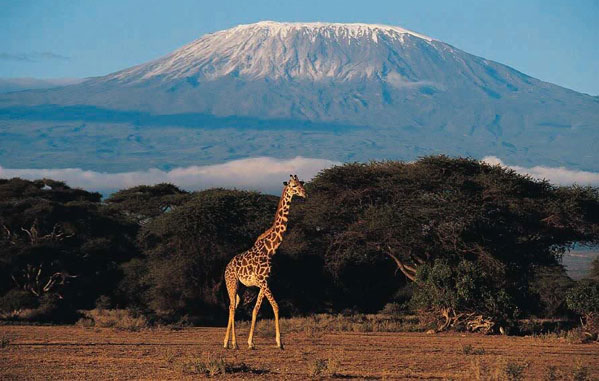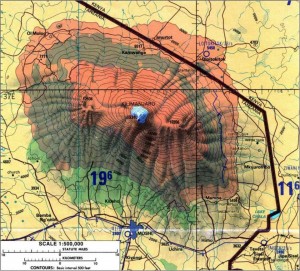County men to scale Mt. Kilimanjaro
Administrator | Jan 04, 2012 | Comments 1
 They’ve been training for more than six months because the prospect of scaling a mountain is as exciting as it is daunting.
They’ve been training for more than six months because the prospect of scaling a mountain is as exciting as it is daunting.
Kemp Stewart, owner of Hillier Creek Estates and President of the Prince Edward County Chamber of Tourism and Commerce and Chris Braney, owner of Cold Creek Vineyards and CAO of the Alzheimer Society of Durham Region left today for a mission to climb Mount Kilimanjaro to raise funds for the Alzheimer Society of Prince Edward during Alzheimer’s Awareness Month, January 2012.
UPDATE: Chris Braney and I arrived in Amsterdam shortly after 7:00 AM on Thursday January 6, 2012. Thinking that Boeing 747’s had been long since retired from passenger service, but I was wrong…
DAY ONE: Some of our group are arriving late evening at Kilimanjaro Airport outside Arusha, where we are met by the Trip Leader Bonaventure Kivuyo. Bonaventure has graduated from Arusha Technical College and has been leading trips on Mount Kilimanjaro over 100 times since 1997. We have a drive of about two hours to a private camp set at 6,200 feet on the lower slopes of Mt. Meru (14,900’), one of Africa’s highest and most beautiful volcanoes.
For the full updates, visit their Facebook page http://www.facebook.com/pages/Kemp-Chris-climb-Kilimanjaro-in-support-of-Alzheimer-Society/137559836360010.
 Kemp and Chris share the following preview:
Kemp and Chris share the following preview:
Tanzania, just south of the equator in the middle of Africa, is bounded by the Indian Ocean and is East Africa’s largest country. It is an endlessly fascinating place as much of what we think of about Africa is reflected in Tanzania. Wildlife sanctuaries cover one- third of the country. The dusty Serengeti plains is home of the classic Africa of elephants, antelopes, lions, leopards and cheetahs. That is not why we are going to Tanzania; we have a mountain to climb!
Mount Kilimanjaro is Africa’s highest peak, almost six kilometres high and situated in the north-east part of Tanzania. It will take over a week to ascend and a day and a half to descend, of which I am sure, will be an exhausting but fulfilling challenge. Mount Kilimanjaro or “Kili” as it is commonly called is also a glacier capped dormant volcano, a national park and a World Heritage Site.
At its peak it is 5892 metres (19,340 feet) high and is the world’s tallest free-standing massif covering some 3885 square kilometres. It is also an exceptionally beautiful mountain, both from afar and close- up and is set off by its highest peak, the distinctive snow-capped dome of Kibo. As incredible as it might seem, Kibo’s emblematic white cap may soon be no more. The ice cap and glaciers are retreating at an alarming rate. As an example, in 1912 the ice cap covered just over twelve square kilometres. By 2005, it had shrunk to under two square kilometres, having diminished by a full third over the previous fifteen years. Some researchers believe that the ice cap will disappear completely between 2021 and 2040. Little or no forest management has not been able to stop the ongoing destruction of forest cover on the mountain’s lower slopes even though logging and uncontrolled fires are illegal. Forests trap solar heat so less forest means warmer ambient air, which in turn hastens “the big thaw”. Because of its height and the superstitions which surround it, Kili has exerted an irresistible fascination since it was “discovered” by Europeans in the mid-nineteenth century.
For many visitors, the prospect of scaling the mountain is both exciting as it is daunting. One of the legends of the Chagga tribe describes a great treasure on the mountain, one protected by powerful spirits who punish those foolhardy enough to dare climb it. The modern forms of those spirits are extreme cold, exhaustion and altitude sickness. Tour safety is critically important to the government and the tour industry in general. Anyone wanting to climb Kili must be accompanied by an officially accredited guide and licenced trekking company. The fact that no technical climbing skills are required to reach the summit (it is thought to be the world’s highest non-technical climb) mean that Kili has acquired something of an easy reputation, which is a dangerous misconception and one which should be ignored.
The high altitude and the possibility of a quick ascent mean that an average of a dozen people lose their lives every year, usually as victims of acute mountain sickness (AMS). There is a tendency to climb too quickly, without acclimatizing to the changes in altitude. Almost everyone suffers with headaches and exhaustion on summit day. In fact, less than half of all the individuals who commence the climb actually complete it to the highest peak. One of the major reasons for not completing the climb is a lack of oxygen in the air. To illustrate what it is like, we have heard it described as if you were carrying a forty kilogram backpack uphill, with your chest bound.
At sea level, the percentage of oxygen in the air is about 21% oxygen. However, atmospheric pressure decreases as altitude increases, and the atmospheric pressure at 20,000 feet is less than 55% that of sea level. To carry on this example one step further, assuming the air pressure at sea level is 15 lbs /sq in., at 20,000 feet the air pressure would be 8.25 lbs/sq in or less than 55% of the sea level pressure. At 25,000 feet the air pressure is only 44% of the pressure at sea level and any mountain climbing at that altitude would require the use of oxygen bottles. It is impossible to predict how anyone will do at altitude, but if at any time one is out of breath they are trekking too fast and should slow down to a pace that can be sustained.
Anyone attempting to climb Mount Kilimanjaro should realize that there is the possibility that everyone may not make it to the summit. There are enough guides and porters however, that should that occur they will be able to escort anyone down. Those who have chosen not to proceed to a higher level have still found the experience of hiking on Mount Kilimanjaro to be very worthwhile. Climbing Kili is an expensive business and currently the basic tour costs are $6485.00 US per person. In addition there are park entrance fees, airport departure taxes. By the time all the fees including outrageous transportation rates, porters (2-3) per person depending on the amount of kit to be carried, cook, and rescue fees, equipment rental and gratuities one could expect to spend about $10,000 for this experience. Additionally there are other expenses such as flights to Arusha, related travel expenses, travel insurance, personal equipment purchase, passports and visa, souvenirs etc. that must also be considered. We have been training for more than six months for this experience. Mostly by bike riding (over 6,000 km), walking/hiking/backpacking and using elliptical and weight machines for foul weather days.
The object is to improve overall level of fitness especially aerobic capacity and to get our legs and lungs in shape for the 80 kilometres of trails we will have to trek and the 4000 metres we will have to climb. Once we have successfully climbed to the summit, there is a descent of 4000 metres in less than two days that is extremely tough on the body, especially the knees. Strengthening the quadriceps will really pay off at the end of the trip. It seems that there is a correlation between the number of days spent on the mountain including acclimatizing and the degree of success the trekkers will experience.
Climbing Kili is difficult and usually painful, so one could expect that a huge effort will be required and the participants should avoid the tendency to be overly confident.
Filed Under: Featured Articles
About the Author:



































Way to go Kemp, what an awesome adventure, you are an inspiration to follow your footsteps. I will be looking for the trip tips!